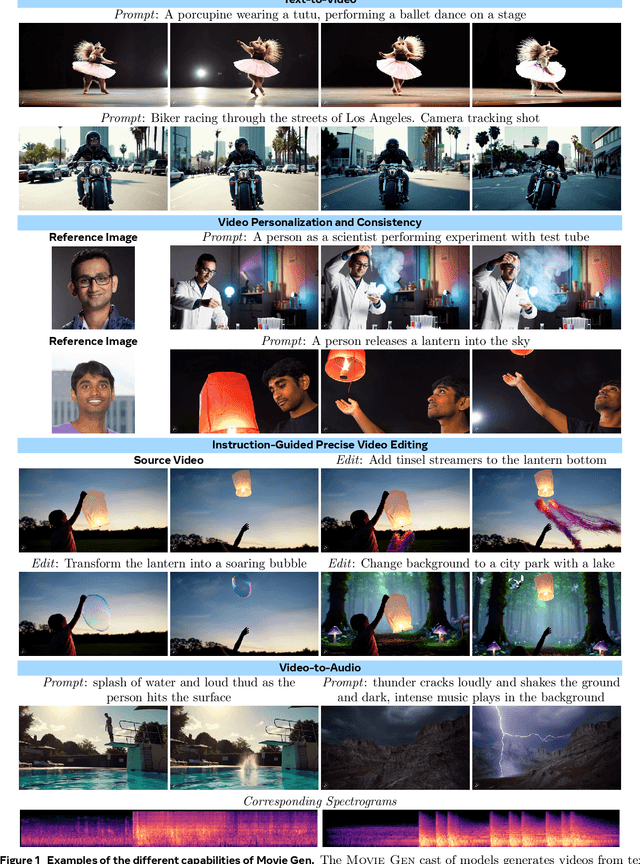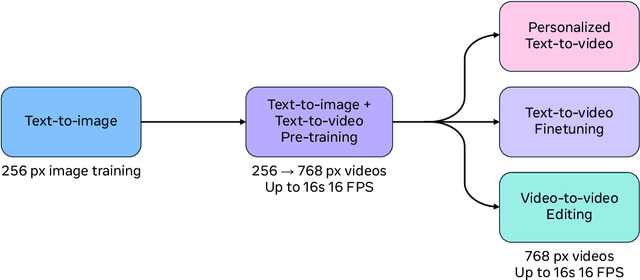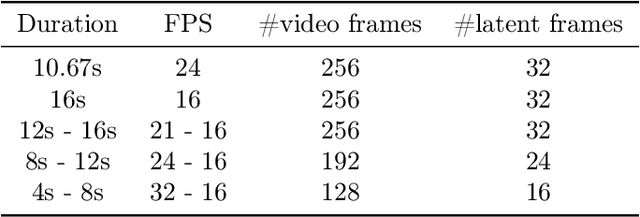Xiaoliang Dai
MoCha: Towards Movie-Grade Talking Character Synthesis
Mar 30, 2025Abstract:Recent advancements in video generation have achieved impressive motion realism, yet they often overlook character-driven storytelling, a crucial task for automated film, animation generation. We introduce Talking Characters, a more realistic task to generate talking character animations directly from speech and text. Unlike talking head, Talking Characters aims at generating the full portrait of one or more characters beyond the facial region. In this paper, we propose MoCha, the first of its kind to generate talking characters. To ensure precise synchronization between video and speech, we propose a speech-video window attention mechanism that effectively aligns speech and video tokens. To address the scarcity of large-scale speech-labeled video datasets, we introduce a joint training strategy that leverages both speech-labeled and text-labeled video data, significantly improving generalization across diverse character actions. We also design structured prompt templates with character tags, enabling, for the first time, multi-character conversation with turn-based dialogue-allowing AI-generated characters to engage in context-aware conversations with cinematic coherence. Extensive qualitative and quantitative evaluations, including human preference studies and benchmark comparisons, demonstrate that MoCha sets a new standard for AI-generated cinematic storytelling, achieving superior realism, expressiveness, controllability and generalization.
DirectorLLM for Human-Centric Video Generation
Dec 19, 2024



Abstract:In this paper, we introduce DirectorLLM, a novel video generation model that employs a large language model (LLM) to orchestrate human poses within videos. As foundational text-to-video models rapidly evolve, the demand for high-quality human motion and interaction grows. To address this need and enhance the authenticity of human motions, we extend the LLM from a text generator to a video director and human motion simulator. Utilizing open-source resources from Llama 3, we train the DirectorLLM to generate detailed instructional signals, such as human poses, to guide video generation. This approach offloads the simulation of human motion from the video generator to the LLM, effectively creating informative outlines for human-centric scenes. These signals are used as conditions by the video renderer, facilitating more realistic and prompt-following video generation. As an independent LLM module, it can be applied to different video renderers, including UNet and DiT, with minimal effort. Experiments on automatic evaluation benchmarks and human evaluations show that our model outperforms existing ones in generating videos with higher human motion fidelity, improved prompt faithfulness, and enhanced rendered subject naturalness.
LinGen: Towards High-Resolution Minute-Length Text-to-Video Generation with Linear Computational Complexity
Dec 13, 2024



Abstract:Text-to-video generation enhances content creation but is highly computationally intensive: The computational cost of Diffusion Transformers (DiTs) scales quadratically in the number of pixels. This makes minute-length video generation extremely expensive, limiting most existing models to generating videos of only 10-20 seconds length. We propose a Linear-complexity text-to-video Generation (LinGen) framework whose cost scales linearly in the number of pixels. For the first time, LinGen enables high-resolution minute-length video generation on a single GPU without compromising quality. It replaces the computationally-dominant and quadratic-complexity block, self-attention, with a linear-complexity block called MATE, which consists of an MA-branch and a TE-branch. The MA-branch targets short-to-long-range correlations, combining a bidirectional Mamba2 block with our token rearrangement method, Rotary Major Scan, and our review tokens developed for long video generation. The TE-branch is a novel TEmporal Swin Attention block that focuses on temporal correlations between adjacent tokens and medium-range tokens. The MATE block addresses the adjacency preservation issue of Mamba and improves the consistency of generated videos significantly. Experimental results show that LinGen outperforms DiT (with a 75.6% win rate) in video quality with up to 15$\times$ (11.5$\times$) FLOPs (latency) reduction. Furthermore, both automatic metrics and human evaluation demonstrate our LinGen-4B yields comparable video quality to state-of-the-art models (with a 50.5%, 52.1%, 49.1% win rate with respect to Gen-3, LumaLabs, and Kling, respectively). This paves the way to hour-length movie generation and real-time interactive video generation. We provide 68s video generation results and more examples in our project website: https://lineargen.github.io/.
Unleashing In-context Learning of Autoregressive Models for Few-shot Image Manipulation
Dec 03, 2024



Abstract:Text-guided image manipulation has experienced notable advancement in recent years. In order to mitigate linguistic ambiguity, few-shot learning with visual examples has been applied for instructions that are underrepresented in the training set, or difficult to describe purely in language. However, learning from visual prompts requires strong reasoning capability, which diffusion models are struggling with. To address this issue, we introduce a novel multi-modal autoregressive model, dubbed $\textbf{InstaManip}$, that can $\textbf{insta}$ntly learn a new image $\textbf{manip}$ulation operation from textual and visual guidance via in-context learning, and apply it to new query images. Specifically, we propose an innovative group self-attention mechanism to break down the in-context learning process into two separate stages -- learning and applying, which simplifies the complex problem into two easier tasks. We also introduce a relation regularization method to further disentangle image transformation features from irrelevant contents in exemplar images. Extensive experiments suggest that our method surpasses previous few-shot image manipulation models by a notable margin ($\geq$19% in human evaluation). We also find our model can be further boosted by increasing the number or diversity of exemplar images.
Towards Automated Model Design on Recommender Systems
Nov 12, 2024Abstract:The increasing popularity of deep learning models has created new opportunities for developing AI-based recommender systems. Designing recommender systems using deep neural networks requires careful architecture design, and further optimization demands extensive co-design efforts on jointly optimizing model architecture and hardware. Design automation, such as Automated Machine Learning (AutoML), is necessary to fully exploit the potential of recommender model design, including model choices and model-hardware co-design strategies. We introduce a novel paradigm that utilizes weight sharing to explore abundant solution spaces. Our paradigm creates a large supernet to search for optimal architectures and co-design strategies to address the challenges of data multi-modality and heterogeneity in the recommendation domain. From a model perspective, the supernet includes a variety of operators, dense connectivity, and dimension search options. From a co-design perspective, it encompasses versatile Processing-In-Memory (PIM) configurations to produce hardware-efficient models. Our solution space's scale, heterogeneity, and complexity pose several challenges, which we address by proposing various techniques for training and evaluating the supernet. Our crafted models show promising results on three Click-Through Rates (CTR) prediction benchmarks, outperforming both manually designed and AutoML-crafted models with state-of-the-art performance when focusing solely on architecture search. From a co-design perspective, we achieve 2x FLOPs efficiency, 1.8x energy efficiency, and 1.5x performance improvements in recommender models.
* Accepted in ACM Transactions on Recommender Systems. arXiv admin note: substantial text overlap with arXiv:2207.07187
Movie Gen: A Cast of Media Foundation Models
Oct 17, 2024



Abstract:We present Movie Gen, a cast of foundation models that generates high-quality, 1080p HD videos with different aspect ratios and synchronized audio. We also show additional capabilities such as precise instruction-based video editing and generation of personalized videos based on a user's image. Our models set a new state-of-the-art on multiple tasks: text-to-video synthesis, video personalization, video editing, video-to-audio generation, and text-to-audio generation. Our largest video generation model is a 30B parameter transformer trained with a maximum context length of 73K video tokens, corresponding to a generated video of 16 seconds at 16 frames-per-second. We show multiple technical innovations and simplifications on the architecture, latent spaces, training objectives and recipes, data curation, evaluation protocols, parallelization techniques, and inference optimizations that allow us to reap the benefits of scaling pre-training data, model size, and training compute for training large scale media generation models. We hope this paper helps the research community to accelerate progress and innovation in media generation models. All videos from this paper are available at https://go.fb.me/MovieGenResearchVideos.
An Analysis on Quantizing Diffusion Transformers
Jun 16, 2024Abstract:Diffusion Models (DMs) utilize an iterative denoising process to transform random noise into synthetic data. Initally proposed with a UNet structure, DMs excel at producing images that are virtually indistinguishable with or without conditioned text prompts. Later transformer-only structure is composed with DMs to achieve better performance. Though Latent Diffusion Models (LDMs) reduce the computational requirement by denoising in a latent space, it is extremely expensive to inference images for any operating devices due to the shear volume of parameters and feature sizes. Post Training Quantization (PTQ) offers an immediate remedy for a smaller storage size and more memory-efficient computation during inferencing. Prior works address PTQ of DMs on UNet structures have addressed the challenges in calibrating parameters for both activations and weights via moderate optimization. In this work, we pioneer an efficient PTQ on transformer-only structure without any optimization. By analysing challenges in quantizing activations and weights for diffusion transformers, we propose a single-step sampling calibration on activations and adapt group-wise quantization on weights for low-bit quantization. We demonstrate the efficiency and effectiveness of proposed methods with preliminary experiments on conditional image generation.
SceneTextGen: Layout-Agnostic Scene Text Image Synthesis with Diffusion Models
Jun 03, 2024



Abstract:While diffusion models have significantly advanced the quality of image generation, their capability to accurately and coherently render text within these images remains a substantial challenge. Conventional diffusion-based methods for scene text generation are typically limited by their reliance on an intermediate layout output. This dependency often results in a constrained diversity of text styles and fonts, an inherent limitation stemming from the deterministic nature of the layout generation phase. To address these challenges, this paper introduces SceneTextGen, a novel diffusion-based model specifically designed to circumvent the need for a predefined layout stage. By doing so, SceneTextGen facilitates a more natural and varied representation of text. The novelty of SceneTextGen lies in its integration of three key components: a character-level encoder for capturing detailed typographic properties, coupled with a character-level instance segmentation model and a word-level spotting model to address the issues of unwanted text generation and minor character inaccuracies. We validate the performance of our method by demonstrating improved character recognition rates on generated images across different public visual text datasets in comparison to both standard diffusion based methods and text specific methods.
Efficient Quantization Strategies for Latent Diffusion Models
Dec 09, 2023



Abstract:Latent Diffusion Models (LDMs) capture the dynamic evolution of latent variables over time, blending patterns and multimodality in a generative system. Despite the proficiency of LDM in various applications, such as text-to-image generation, facilitated by robust text encoders and a variational autoencoder, the critical need to deploy large generative models on edge devices compels a search for more compact yet effective alternatives. Post Training Quantization (PTQ), a method to compress the operational size of deep learning models, encounters challenges when applied to LDM due to temporal and structural complexities. This study proposes a quantization strategy that efficiently quantize LDMs, leveraging Signal-to-Quantization-Noise Ratio (SQNR) as a pivotal metric for evaluation. By treating the quantization discrepancy as relative noise and identifying sensitive part(s) of a model, we propose an efficient quantization approach encompassing both global and local strategies. The global quantization process mitigates relative quantization noise by initiating higher-precision quantization on sensitive blocks, while local treatments address specific challenges in quantization-sensitive and time-sensitive modules. The outcomes of our experiments reveal that the implementation of both global and local treatments yields a highly efficient and effective Post Training Quantization (PTQ) of LDMs.
LEGO: Learning EGOcentric Action Frame Generation via Visual Instruction Tuning
Dec 06, 2023



Abstract:Generating instructional images of human daily actions from an egocentric viewpoint serves a key step towards efficient skill transfer. In this paper, we introduce a novel problem -- egocentric action frame generation. The goal is to synthesize the action frame conditioning on the user prompt question and an input egocentric image that captures user's environment. Notably, existing egocentric datasets lack the detailed annotations that describe the execution of actions. Additionally, the diffusion-based image manipulation models fail to control the state change of an action within the corresponding egocentric image pixel space. To this end, we finetune a visual large language model (VLLM) via visual instruction tuning for curating the enriched action descriptions to address our proposed problem. Moreover, we propose to Learn EGOcentric (LEGO) action frame generation using image and text embeddings from VLLM as additional conditioning. We validate our proposed model on two egocentric datasets -- Ego4D and Epic-Kitchens. Our experiments show prominent improvement over prior image manipulation models in both quantitative and qualitative evaluation. We also conduct detailed ablation studies and analysis to provide insights on our method.
 Add to Chrome
Add to Chrome Add to Firefox
Add to Firefox Add to Edge
Add to Edge